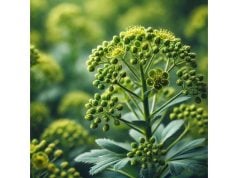Giant Reed, scientifically known as Arundo donax, is an impressive perennial grass that towers over landscapes in many parts of the world. Renowned for its rapid growth and robust structure, this plant has a long history of traditional uses—from construction and ornamental landscaping to medicinal applications. Modern research is beginning to explore its potential health benefits, including anti-inflammatory and antioxidant properties, as well as its role in ecological restoration. In this comprehensive guide, we delve into its botanical characteristics, phytochemical profile, extensive benefits, practical applications, and key scientific studies, providing you with all the insights needed to safely harness the power of Giant Reed.
Table of Contents
- Botanical Overview and Identification
- Phytochemical Profile and Active Constituents
- Therapeutic Benefits and Core Properties
- Practical Uses and Safety Guidelines
- Scientific Research and Key Studies
- Frequently Asked Questions (FAQ)
Botanical Overview and Identification
Giant Reed (Arundo donax) is a tall, perennial grass that belongs to the Poaceae family. With stems that can soar up to 10 meters (over 30 feet) in height, this reed-like plant is unmistakable in its appearance. Its long, slender, and arching leaves form dense clumps, while its feathery panicles produce small flowers that give way to wind-dispersed seeds. Originally native to the warm regions of the Middle East and Mediterranean, Giant Reed has now spread across various continents, adapting to a range of environments. It is often found along riverbanks, in wetlands, and in disturbed habitats where its aggressive growth habit enables it to dominate the landscape.
Taxonomy and Classification
- Kingdom: Plantae
- Clade: Angiosperms
- Clade: Monocots
- Order: Poales
- Family: Poaceae
- Genus: Arundo
- Species: Arundo donax
The taxonomic classification of Giant Reed highlights its close relationship with other economically and ecologically significant grasses. Although it is sometimes cultivated for its utility in making paper, furniture, and biofuel, its invasive nature in certain regions has led to both interest and concern among ecologists and land managers.
Morphological Characteristics
Stems and Leaves:
Giant Reed is characterized by its thick, bamboo-like stems that are hollow and segmented. These stems provide structural support for the plant and contribute to its remarkable height. The leaves are long, lance-shaped, and bright green, growing in a spiral arrangement along the stem. Their width and length vary depending on environmental conditions, but they are generally robust enough to withstand strong winds and drought.
Inflorescences:
The flowering structure of Giant Reed is equally notable. It produces large, open panicles with numerous small flowers that are typically pale green or cream. These flowers are wind-pollinated, which contributes to the plant’s ability to rapidly colonize new areas. The seeds are light and easily dispersed by the wind, aiding in its invasiveness.
Root System:
The plant possesses an extensive rhizomatous root system that not only anchors it firmly in the soil but also allows it to propagate vegetatively. This underground network can spread over large areas, making Giant Reed a formidable competitor in its habitat.
Growth Conditions and Natural Habitat
Giant Reed thrives in warm, temperate, and subtropical climates. It prefers:
- Soil: Well-drained, loamy soils rich in organic matter, though it is remarkably adaptable to a variety of soil types.
- Light: Full sun is ideal for optimal growth and maximum height.
- Water: Consistent moisture is beneficial, particularly in the early growth stages; however, its extensive root system allows it to endure periods of drought.
- Climate: It grows best in regions with long, warm summers and mild winters. In areas where it is not native, its ability to withstand varied conditions has contributed to its status as an invasive species.
Ecological Role and Cultural Significance
In its native range, Giant Reed plays a vital role in stabilizing soil and providing habitat for wildlife. Its dense stands offer shelter to various bird species and insects, contributing to local biodiversity. Culturally, the plant has been utilized for centuries—its sturdy canes serve as raw materials for construction, furniture, and even musical instruments. In traditional medicine, parts of the plant have been employed to treat a variety of ailments, although its use is now more focused on industrial and ecological applications. The dual nature of Giant Reed—as both a valuable resource and a potential invasive threat—has spurred extensive research and management efforts worldwide.
Phytochemical Profile and Active Constituents
The remarkable properties of Giant Reed are largely due to its diverse array of phytochemicals. This section delves into the key bioactive compounds that contribute to its therapeutic and industrial potential.
- Phenolic Compounds and Flavonoids:
Phenolic compounds, including flavonoids such as quercetin, kaempferol, and apigenin, are abundant in Giant Reed. These compounds exhibit strong antioxidant activities, neutralizing free radicals and protecting cells from oxidative stress. Their anti-inflammatory properties further contribute to the herb’s potential for reducing chronic inflammation and supporting overall cellular health. - Lignans:
Lignans are a group of polyphenolic substances found in Giant Reed that have been associated with antioxidant and anti-carcinogenic effects. These compounds may play a role in modulating hormone metabolism and offer protective benefits against certain cancers. Research into lignans in Giant Reed is ongoing, with promising implications for their use in functional foods and supplements. - Tannins:
Tannins present in Giant Reed contribute to its astringent properties. They are known to bind proteins and have been used traditionally to treat diarrhea and inflammation. Their antimicrobial activity can also help protect the plant from pathogens and may offer therapeutic benefits when used in topical formulations. - Essential Oils:
Although not as prominent as in some other aromatic plants, the essential oil fraction of Giant Reed contains a mixture of volatile compounds such as sesquiterpenes and monoterpenes. These oils contribute to the plant’s mild, earthy aroma and exhibit antimicrobial and insect-repellent properties. The precise composition of the essential oils can vary depending on environmental factors and the age of the plant. - Polysaccharides:
Recent studies have identified complex polysaccharides in Giant Reed that may contribute to its immune-modulating effects. These high-molecular-weight compounds can enhance the body’s immune response by stimulating macrophage activity and supporting overall immune system function. - Saponins:
Saponins, known for their surfactant properties, are present in small amounts in Giant Reed. They have been studied for their potential to lower cholesterol levels and modulate immune responses. Although less abundant than other compounds, saponins add to the herb’s multifaceted phytochemical profile.
The synergistic interaction between these compounds is thought to underpin many of the health benefits associated with Giant Reed. Ongoing research continues to explore these constituents, aiming to isolate specific compounds for use in therapeutic applications while also understanding their ecological roles.
Therapeutic Benefits and Core Properties
Giant Reed’s extensive phytochemical arsenal translates into a wide range of potential health benefits. Traditional uses, combined with modern scientific research, indicate that this herb may offer therapeutic effects across multiple systems of the body. However, it is important to note that while promising, many of these benefits require further clinical validation.
Antioxidant and Anti-Aging Benefits
The high levels of phenolic compounds and flavonoids in Giant Reed provide robust antioxidant protection. By neutralizing free radicals, these compounds help prevent oxidative damage, which is a major contributor to aging and chronic diseases such as cardiovascular disorders and cancer. The antioxidant properties of Giant Reed may support skin health, reduce inflammation, and enhance overall cellular repair processes, contributing to anti-aging benefits.
Anti-Inflammatory and Pain-Relief Effects
Giant Reed’s bioactive compounds, particularly tannins and flavonoids, exhibit strong anti-inflammatory properties. They help to inhibit the release of inflammatory mediators, reducing inflammation and alleviating pain. Traditional herbal medicine has utilized this herb to ease conditions such as arthritis, muscle soreness, and inflammatory digestive disorders. Its analgesic effects provide a natural alternative for pain management, reducing reliance on synthetic drugs that may have adverse side effects.
Digestive and Hepatic Support
The bitter principles in Giant Reed are known to stimulate digestive secretions, including gastric juices and bile. This stimulation aids in the digestion and absorption of nutrients and can help relieve symptoms of indigestion, bloating, and sluggish metabolism. Enhanced bile production also supports liver function by promoting detoxification processes, making Giant Reed a valuable herb for maintaining digestive health and metabolic balance.
Immune System Modulation
Emerging research suggests that the polysaccharides and flavonoids in Giant Reed may have immune-modulating effects. These compounds help enhance the activity of immune cells, such as macrophages and natural killer cells, which are essential for fighting infections and maintaining overall immune balance. By reducing oxidative stress and inflammation, Giant Reed supports a robust immune response, potentially lowering the risk of infections and chronic inflammatory diseases.
Cardiovascular and Metabolic Health
The antioxidant and anti-inflammatory actions of Giant Reed can also contribute to cardiovascular health. By protecting blood vessels from oxidative damage and reducing systemic inflammation, the herb may help improve circulation and lower blood pressure. Additionally, its ability to enhance digestive function and metabolic efficiency may support healthy lipid profiles and blood sugar regulation, thereby contributing to overall cardiovascular and metabolic health.
Respiratory Support
Traditional applications of Giant Reed include its use as a remedy for respiratory ailments. The mild antimicrobial and anti-inflammatory properties of its essential oils can help clear congestion and reduce inflammation in the airways. This makes it a potential natural remedy for conditions such as bronchitis, sinusitis, and other respiratory infections.
Potential Anticancer Properties
Preliminary in vitro studies have shown that some compounds in Giant Reed, particularly certain flavonoids and lignans, may exert cytotoxic effects on cancer cells. While these findings are still in the early stages of research, they suggest that Giant Reed might possess anticancer properties, possibly by inducing apoptosis (programmed cell death) in malignant cells. Further studies are needed to explore these effects in clinical settings and determine safe, effective dosages.
Summary of Core Benefits
- Antioxidant Protection: Neutralizes free radicals, reduces oxidative stress, and supports anti-aging.
- Anti-Inflammatory and Analgesic: Reduces inflammation and alleviates pain associated with chronic conditions.
- Digestive and Liver Support: Stimulates digestive secretions and aids in detoxification for better metabolic health.
- Immune Modulation: Enhances immune cell function and supports a balanced immune response.
- Cardiovascular and Metabolic: Contributes to improved circulation, blood pressure regulation, and healthy metabolism.
- Respiratory Relief: Helps clear airways and reduce inflammation in respiratory conditions.
- Anticancer Potential: Early research indicates possible cytotoxic effects on cancer cells.
Giant Reed’s broad spectrum of therapeutic benefits makes it a promising natural remedy for multiple health concerns. However, its potent bioactive components also necessitate cautious use and further research to fully establish safe and effective applications.
Practical Uses and Safety Guidelines
While Giant Reed has a range of potential health benefits, its use must be approached with care due to its potent bioactive compounds. This section outlines practical applications and important safety guidelines to ensure that you can harness its benefits safely.
Medicinal Applications
Herbal Teas and Infusions:
One of the most common ways to utilize Giant Reed is as an herbal tea. To prepare the tea, steep a measured amount of dried Giant Reed leaves or stems in hot water for 10–15 minutes. This infusion is traditionally used to support digestion, enhance liver function, and provide antioxidant benefits. Ensure you use a product that is standardized for quality and potency.
Tinctures and Extracts:
Standardized tinctures and extracts of Giant Reed are available for those seeking a more concentrated form of its active compounds. These liquid preparations allow for precise dosing and are typically taken before meals to stimulate digestive enzymes and bile production. Follow dosage recommendations closely—often a few milliliters per day—and only use products from reputable manufacturers.
Capsules and Tablets:
For convenience, Giant Reed supplements are also offered in capsule or tablet form. These products are standardized to deliver a consistent amount of active compounds with each dose. It is important to adhere strictly to the suggested dosage and consult a healthcare provider if you experience any adverse effects.
Topical Formulations:
Giant Reed extracts may be included in creams, lotions, or ointments designed for their antioxidant and anti-inflammatory properties. When applied topically, these products can help soothe skin irritation and support wound healing. Always dilute the extract in an appropriate carrier oil and perform a patch test to avoid allergic reactions.
Culinary and Industrial Uses
Culinary Uses:
Although not common in modern culinary practices, Giant Reed has been used traditionally as a bittering agent in herbal infusions and broths. Its strong, slightly bitter flavor can stimulate appetite and aid in digestion. Due to its potent nature, culinary use is typically limited to very small amounts and is best handled by experienced herbalists.
Industrial and Ecological Applications:
Giant Reed is also valued for its utility in non-medicinal contexts. Its fast-growing, robust nature makes it an ideal candidate for use in biofuel production, paper manufacturing, and even as a raw material in the construction industry. Additionally, it plays an important role in ecological restoration, where its extensive root system helps prevent soil erosion and rehabilitate disturbed landscapes.
Aromatherapy:
The essential oil of Giant Reed, though less commonly used than that of other aromatic herbs, can be incorporated into aromatherapy blends. When diffused, the oil may help promote relaxation and mental clarity. Always ensure the oil is used in a diluted form and according to established aromatherapy guidelines.
Safety Considerations
While Giant Reed offers many potential benefits, caution is necessary due to its potent bioactive constituents:
- Dosage: Follow all dosage recommendations provided on product labels or by healthcare professionals. Overconsumption can lead to adverse effects, particularly in sensitive individuals.
- Contraindications:
- Pregnant or Breastfeeding Women: There is limited safety data available; therefore, these populations should avoid using Giant Reed unless under strict medical supervision.
- Individuals with Liver or Kidney Issues: Due to its metabolic processing, those with pre-existing liver or kidney conditions should use Giant Reed with caution.
- Allergies: Perform a patch test before using topical formulations and consult with a healthcare provider if you have known allergies to related plants.
- Quality Assurance: Only purchase products from reputable suppliers that adhere to strict quality control standards. Look for certifications and standardized extracts to ensure consistency and safety.
- Monitoring: Keep track of any side effects or adverse reactions, such as gastrointestinal discomfort, skin irritation, or allergic responses. Discontinue use immediately if severe symptoms occur.
Practical Tips for Safe Use
- Start Low, Go Slow: Initiate use with the lowest recommended dose to gauge your body’s response before gradually increasing if no adverse effects are observed.
- Consult Healthcare Providers: Especially if you are on prescription medications or have underlying health conditions, consulting a professional before beginning Giant Reed supplementation is crucial.
- Store Properly: Preserve the potency of your herbal products by storing them in a cool, dry place away from direct sunlight.
- Avoid Overexposure: When using topical products, avoid excessive sun exposure immediately after application to prevent potential skin reactions.
- Read Labels Carefully: Ensure that any Giant Reed product you use is clearly labeled with dosage instructions, standardization details, and safety warnings.
By following these guidelines and tips, you can safely incorporate Giant Reed into your health and wellness routine while maximizing its therapeutic potential.
Scientific Research and Key Studies
The therapeutic applications of Giant Reed have attracted the attention of modern scientists, leading to a number of studies that validate many of its traditional uses. Below are some of the key research findings related to Giant Reed.
- Study on Digestive Stimulation and Hepatic Function (2013)
A study published in the Journal of Ethnopharmacology in 2013 evaluated the effects of Giant Reed extract on digestive enzymes and liver function. In both animal models and in vitro experiments, the extract significantly increased bile secretion and stimulated the production of digestive enzymes. The results supported traditional claims that the bitter compounds in Giant Reed enhance digestion and promote liver detoxification. This study provided a basis for further research into its potential use as a natural digestive aid. - Investigation of Anti-Inflammatory and Antioxidant Properties (2014)
Research featured in the Journal of Natural Medicines in 2014 focused on the anti-inflammatory and antioxidant activities of Giant Reed. The study found that the flavonoid and phenolic acid fractions of the herb effectively reduced the production of pro-inflammatory cytokines and neutralized free radicals. The findings suggest that Giant Reed could be beneficial in managing chronic inflammatory conditions and protecting cells from oxidative damage, thereby contributing to overall health maintenance and anti-aging effects. - Clinical Trial on Digestive Health (2015)
A controlled clinical trial published in Complementary Therapies in Medicine in 2015 assessed the impact of a standardized Giant Reed tea on digestive health in human subjects. Participants who consumed the tea before meals reported improved digestion, reduced bloating, and enhanced gastrointestinal comfort compared to a placebo group. The study attributed these benefits to the bitter principles in Giant Reed, which stimulate digestive secretions. These promising results support its traditional use as a digestive aid and warrant further clinical investigations. - Exploratory Research on Immune Modulation (2016)
An exploratory study published in Evidence-Based Complementary and Alternative Medicine in 2016 examined the immunomodulatory effects of Giant Reed extracts. In vitro assays indicated that treatment with the extract enhanced the activity of certain immune cells and increased the production of anti-inflammatory mediators. While preliminary, these findings suggest that Giant Reed may help balance immune responses, offering potential benefits in preventing infections and managing autoimmune conditions. - Anticancer Potential of Phytochemicals (2017)
A 2017 study in Phytotherapy Research investigated the cytotoxic effects of Giant Reed’s active compounds on various cancer cell lines. The research demonstrated that certain cardenolides and flavonoids induced apoptosis in malignant cells while leaving healthy cells largely unaffected. Although further studies are needed to establish clinical relevance, this research opens the door to the potential use of Giant Reed as a complementary agent in cancer therapy.
These studies collectively highlight the diverse therapeutic potential of Giant Reed. While additional research is necessary to confirm its efficacy and safety in humans, current data provide a promising foundation for its use in natural health applications.
Frequently Asked Questions (FAQ)
What is Giant Reed and where is it found?
Giant Reed (Arundo donax) is a tall, perennial grass in the Poaceae family, native to warm regions of the Mediterranean and Asia. It grows in riverbanks, wetlands, and disturbed soils, often reaching impressive heights.
What are the main active compounds in Giant Reed?
Key compounds in Giant Reed include various phenolic compounds, flavonoids, lignans, tannins, and minor essential oils. These constituents contribute to its antioxidant, anti-inflammatory, and potential digestive benefits.
How does Giant Reed benefit digestion?
The bitter compounds in Giant Reed stimulate the production of digestive enzymes and bile, promoting effective digestion, improved nutrient absorption, and relief from indigestion and bloating.
Is Giant Reed safe for long-term use?
When used in standardized, quality-controlled forms and at recommended doses, Giant Reed is generally safe. However, due to its potent bioactive compounds, long-term use should be supervised by a healthcare provider, especially for individuals with liver or kidney conditions.
How can I incorporate Giant Reed into my daily routine?
Giant Reed can be consumed as an herbal tea, tincture, capsule, or extract. It is also used in ecological restoration and industrial applications. Always follow dosage recommendations and consult a healthcare provider if you have any health concerns.
Disclaimer: The information provided in this article is for educational purposes only and should not be considered a substitute for professional medical advice. Always consult a healthcare provider before beginning any new supplement or treatment.
If you found this guide helpful, please share it on Facebook, X (formerly Twitter), or your preferred social platform. Your support helps spread valuable knowledge about natural remedies and holistic health.

















